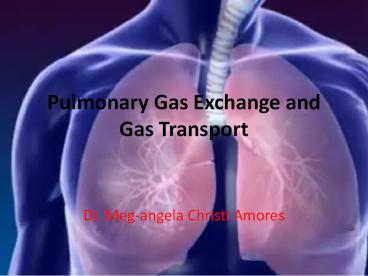Pulmonary Gas Exchange and Gas Transport - PowerPoint PPT Presentation
Title:
Pulmonary Gas Exchange and Gas Transport
Description:
Pulmonary Gas Exchange and Gas Transport Dr. Meg-angela Christi Amores Physiologic Anatomy One of the most important problems in all the respiratory passages is to ... – PowerPoint PPT presentation
Number of Views:1668
Avg rating:3.0/5.0
Title: Pulmonary Gas Exchange and Gas Transport
1
Pulmonary Gas Exchange and Gas Transport
- Dr. Meg-angela Christi Amores
2
Physiologic Anatomy
- One of the most important problems in all the
respiratory passages is to keep them open to
allow easy passage of air to and from the alveoli - Trachea with cartilage rings 5/6 of the way
around - Bronchi walls have less extensive cartilage
plates - Bronchioles no plates. Diameter lt1.5mm, all
smooth muscles - Kept expanded by same transpulmonary pressures
that expand the alveoli
3
(No Transcript)
4
Physiologic Anatomy
- All areas of the trachea and bronchi not occupied
by cartilage plates, walls are composed of smooth
muscles - Resistance to flow is greatest NOT in the minute
air passages of terminal bronchioles but in some
of the larger bronchi near to the trachea. - Smaller airways are easily occluded
- smooth muscles contract easily
5
Pulmonary Circulatory System
- Pulmonary Vessels
- Pulmonary artery (5 cm, thin, 2x VC, 1/3 aorta)
- Right and Left main pulmonary branches lungs
- Large compliance (7 mL/mmHg)
- Allows pulmonary arteries to accommodate 2/3 of
stroke volume output of Right Ventricle - Bronchial Vessels arterial supply to the lungs
- 1/3 of cardiac output
- Supplies supporting tissues (CT, septa, bronchi)
- Drains to pulmonary veins
6
Pulmonary vs. Alveolar Ventilation
- Pulmonary Ventilation
- Inflow and outflow of air
between the atmosphere
and the lung alveoli - Alveolar Ventilation
- Rate at which new air reaches the areas in the
lung where it is in proximity to the pulmonary
blood or gas exchange areas (alveolar sacs,
ducts, respiratory bronchioles)
7
Diffusion of Gases
- Diffusion
- Random molecular motion of molecules with energy
provided by kinetic motion of the molecules - All molecules are continually undergoing motion
except in absolute zero temperature - Net diffusion
- Product of diffusion from high to low
concentration
8
Gas Pressures
- Partial Pressure
- Pressure is directly proportional to the
concentration of gas molecules caused by impact
of moving molecules against a surface - In respiration, theres mixture of gases O2, N2,
CO2 - Rate of diffusion of each gas is directly
proportional to the pressure caused by each gas
alone - AIR total Pressure 760 mmHg
- 79 N, 21 O2 PP N 600mmHg , PP O2
160mmHg
9
Gas Pressure in Fluid
- Determined by its concentration and by solubility
coefficient - If gas is repelled, pressure increases
- HENRYs LAW Pressure concentration
- solubility coefficient
10
Solubility of Gases in body temp.
- O2 0.024
- CO2 0.57 - 20x more soluble than O2
- CO 0.018
- N2 0.012
- He 0.008
11
Factors that affect Rate of Gas Diffusion thru
Respiratory Membrane
- Respiratory Unit
- Respiratory bronchiole
- Alveolar ducts
- Atria
- Alveoli (300 Million in both lungs) (0.2mm)
- their membranes make up the respiratory membrane
12
Respiratory Membrane
- Layers
- Layer of fluid lining alveolus
(surfactant) - Alveolar epithelium
- Epithelial basement membrane
- Interstitial Space
- Capillary basement membrane
- Capillary endothelial membrane
- Overall thickness 0.2um (ave 0.6 um)
- Total surface area 70 m2
13
Factors that affect Rate of Gas Diffusion thru
Respiratory Membrane
- Thickness of membrane
- Inc. in edema and fibrosis
- Surface area of membrane
- Dec. in removal of lung and emphysema
- Diffusion coefficient of Gas in substance of
membrane - Gas solubility
- Pressure difference
- Difference between partial pressure of gas in
alveoli and pressure of gas in pulmonary
capillary blood
14
Ventilation-Perfusion Ratio
- A concept developed to help us understand
respiratory exchange where there is imbalance
between alveolar ventilation and alveolar blood
flow - Areas in lung with well ventilation but no
bloodflow or excellent blood flow but no
ventilation - Va alveolar ventilation
- Q blood flow
15
Ventilation-Perfusion Ratio
- Va/Q normal
- If Va is 0 (zero), but with perfusion Va/Q 0
- If Va is present, but no perfusion Va/Q
infinity - In both there is no gas exchange
16
Ventilation-Perfusion Ratio
- Normal person
- Upright Va and Q are less in Upper part but Q is
more - At top of lung Va/Q 2.5x gt as ideal
physiologic dead space (ventilation but less
blood flow) - At bottom Va is less than Q
- Va/Q is 0.6 lt as ideal physiologic shunt
- COPD patient
- Smoker, emphysema, alveolar walls destroyed
- Wasted blood flow severe shunting
17
Transport of O2 and CO2
- Pressure differences causes gas to diffuse
Alveolus Capillaries Tissues (fluid) Tissues (cells)
pO2 104 mmHg 95 mmHg 40 mmHg 5-40 (ave 23) mmHg
pCO2 40 mmHg 45 mmHg 45 mmHg 46 mmHg
18
Transport of O2 and CO2
- CO2 can diffuse about 20 times as rapidly as O2
- Transport of O2 in blood
- 97 of O2 from lungs to tissues are carried in
combination with hemoglobin - O2 combines loosely and reversibly with heme
- pO2 O2 combines with heme (pulm capi)
- pO2 O2 is released (tissue capillaries)
19
- For the next meeting, read on Regulation of
Respiration - Guyton Textbook of Medical Physiology, 10th
edition Chapter 41































